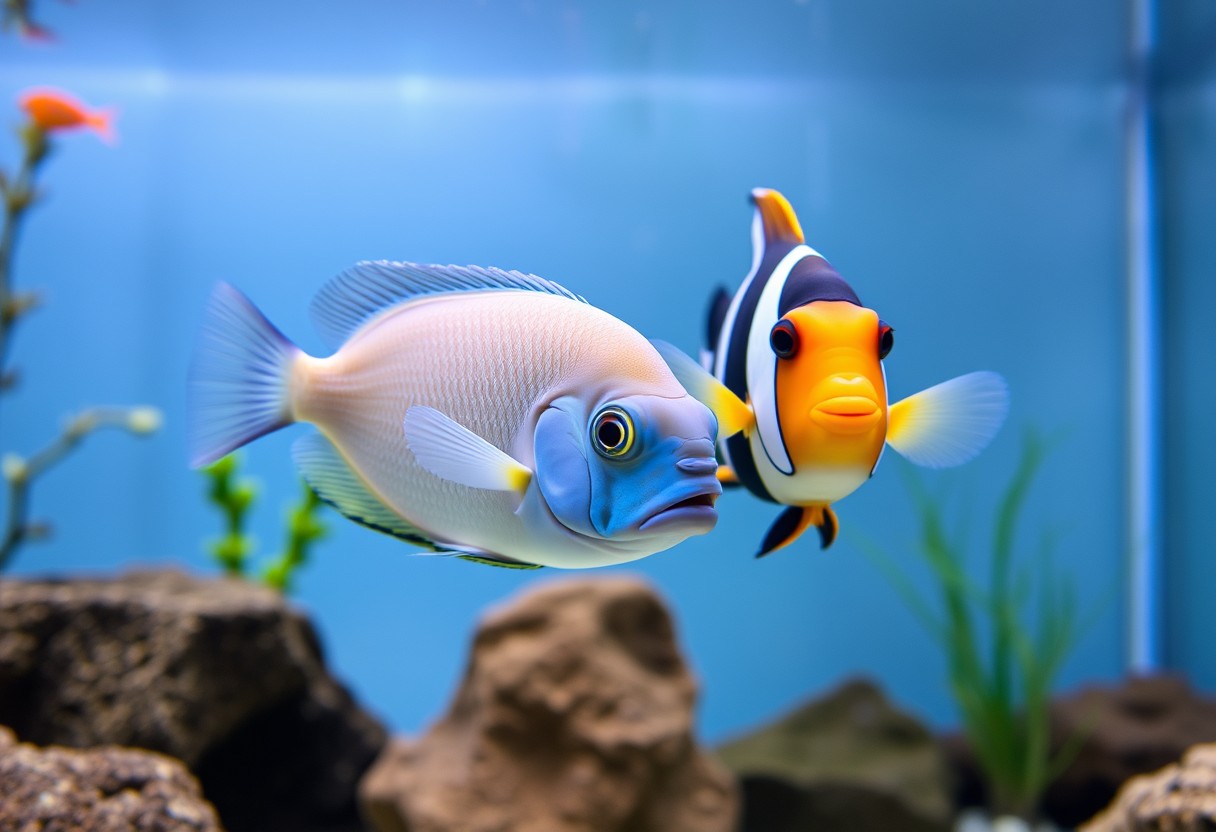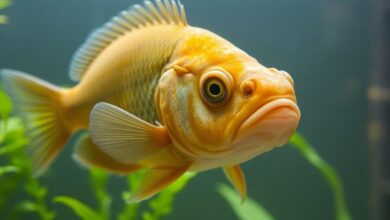Blue Face Brichardii Fish & Oscar Fish – Care Tips

Just submerging into the world of aquaristics can be exciting, especially when it comes to caring for Blue Face Brichardii and Oscar Fish. These vibrant species can bring life to your aquarium, but they do have specific requirements that must be met to ensure their well-being. By understanding their habitat, diet, and social needs, you’ll be better equipped to create a thriving environment for your fish. Follow these crucial care tips to keep your aquatic friends healthy, happy, and overflowing with color in your tank.
Key Takeaways:
- Tank Size: Both Blue Face Brichardii Fish and Oscar Fish require spacious tanks, with at least 75 gallons for Oscars and 30 gallons for Brichardii to thrive comfortably.
- Water Conditions: Maintain stable water parameters for both species, including temperature, pH, and hardness, to promote a healthy environment.
- Feeding: Provide a varied diet featuring high-quality pellets, live foods, and vegetables to ensure optimal growth and coloration.

Blue Face Brichardii Fish
For those looking to add a vibrant and unique species to their aquarium, the Blue Face Brichardii fish is a wonderful choice. This cichlid, known for its striking blue face and social behavior, thrives in a well-maintained environment and with proper care. Understanding its needs is important to ensure your fish remains healthy and vibrant.
Natural Habitat
Against the backdrop of Lake Tanganyika in Africa, the Blue Face Brichardii fish flourishes in rocky environments. This natural habitat is characterized by clear waters and abundant hiding spots, which provide shelter and breeding grounds. To mimic these conditions in your aquarium, you should incorporate rocks and caves to help your fish feel secure.
Care Requirements
Before introducing Blue Face Brichardii fish into your aquarium, it’s important to consider their specific care requirements. A well-sized tank with good water quality, stable pH levels, and the right temperature range (around 75-82°F) is important. These fish are known to be territorial, so providing adequate hiding places and a proper diet, including high-quality pellets and occasional frozen foods, will help maintain their health.
A successful care regimen for the Blue Face Brichardii fish includes monitoring the water parameters to ensure they remain stable and suitable for their needs. Frequent water changes, maintaining a pH of 8.0-9.0, and keeping the hardness around 10-20 dGH will favor their growth and well-being. Additionally, feeding a balanced diet allows your fish to maintain its bright colors and strong immune system. By observing your fish regularly, you can manage any signs of stress or illness quickly.
Oscar Fish
Some of the most popular aquarium fish, Oscar Fish are known for their vibrant colors and unique personalities. They are intelligent creatures that can recognize their owners and exhibit a range of behaviors. If you’re interested in learning more about the Blue Face Brichardii Fish and Oscar Fish, you’ll find they can thrive together in a well-maintained tank.
Overview and Characteristics
Between their striking appearance and engaging behavior, Oscar Fish are a standout species in the aquarium trade. These fish can grow quite large, reaching lengths of up to 12-18 inches, and showcase a variety of colors, including orange, black, and red hues, often with unique patterns.
Care Needs
With the right care, Oscar Fish can thrive and provide you with years of enjoyment. They require a spacious tank of at least 55 gallons to accommodate their potential size and provide adequate swimming space.
In fact, it’s important to maintain a stable environment for your Oscar Fish, which includes regular water changes and monitoring water parameters like pH, ammonia, and nitrate levels. They thrive in temperatures between 75°F and 85°F and need a strong filtration system due to their messy eating habits. Providing a varied diet, rich in protein, will ensure they remain healthy. Additionally, do not house them with small fish, as Oscars can be aggressive and may see them as prey, posing a significant risk to your tank’s inhabitants.

Tank Setup
Once again, setting up a suitable tank for your Blue Face Brichardii and Oscar fish is necessary for their health and well-being. Choose a tank that provides ample swimming space and hiding spots. Incorporate rocks and plants for Brichardii Cichlids to establish territories and feel secure. For detailed care guidelines, check Brichardi Cichlid (Neolamprologus brichardi): Ultimate ….
Ideal Tank Size
Ideal tank size for Blue Face Brichardii is at least 30 gallons, while Oscars require a minimum of 55 gallons. A larger tank will help maintain water quality and provide more space for both species.
Water Parameters
Any successful aquarium setup demands specific water parameters for your fish to thrive. Aim for a temperature between 75°F and 82°F, a pH level of 7.0 to 8.0, and hardness between 10-20 dGH. Maintaining these conditions is vital to prevent stress and illness in your fish.
To ensure a stable environment, conduct regular water changes and monitor your water parameters frequently. Fluctuations in temperature and pH can lead to stress and make your fish susceptible to disease. Keeping your tank well-filtered and oxygenated also promotes a healthy ecosystem for your Blue Face Brichardii and Oscar fish.
Feeding Practices
Many aquarists find that understanding the feeding practices for your Blue Face Brichardii Fish and Oscar Fish is necessary for their well-being. Both species thrive on a balanced diet that reflects their natural feeding habits. Providing the right food will not only enhance their color and growth but also maintain their overall health. You can choose from a variety of options, including pellets, flakes, and frozen foods tailored for cichlids.
Diet Essentials
Around 70% of your Blue Face Brichardii Fish and Oscar Fish’s diet should consist of high-quality pellets specifically made for cichlids. Include protein-rich offerings like brine shrimp, bloodworms, and other frozen foods to diversify their diet. Additionally, incorporating vegetable matter, such as spirulina flakes or blanched vegetables, will ensure they receive necessary nutrients, promoting optimal health.
Feeding Schedule
Schedule your feeding times to provide a consistent routine for your fish. Typically, feeding your Blue Face Brichardii Fish and Oscar Fish 1-2 times a day is suitable. It’s important to offer only what they can consume in a few minutes to prevent overfeeding, which can lead to health complications and water quality issues.
Another key aspect of your feeding schedule is to establish a pattern that your fish can adapt to. Try to feed them at the same time each day to create a routine. This not only helps in their digestion but also prevents any stress caused by irregular feeding. Moreover, avoid feeding them late in the evening, as uneaten food can pollute the tank. Overfeeding can lead to swim bladder issues, malnutrition, or even death, so always monitor their intake and adjust accordingly.
Compatibility with Other Fish
To ensure a successful aquarium, it’s crucial to know the compatibility of Blue Face Brichardii and Oscar Fish with other species. Both fish belong to the Cichlid family and can exhibit varying levels of aggression, making it imperative to choose tankmates wisely. It’s advisable to consult this Cichlid compatibility guide for making informed decisions about mixing different species.
Best Tankmates for Blue Face Brichardii
Brichardii thrives in a community tank that includes other peaceful African cichlids, as they can be territorial when breeding. Opt for tankmates like the Julidochromis, Lamprichthys, and smaller catfish to create a balanced ecosystem. Be cautious with fin-nippers and overly aggressive fish.
Oscar Fish Compatibility
Any Oscar Fish can display moderate to high aggression levels, so it’s vital to select tankmates that can handle its temperament. Suitable companions include larger cichlids like the Jaguar and Green Terror, which can stand their ground. Smaller fish may be seen as prey, so it’s best to avoid them.
With Oscar Fish, you should focus on pairing them with species that are of a similar size and aggression level. This creates a harmonious environment while eliminating stress in your tank. When introducing new fish, do so gradually to avoid territorial disputes. Keep in mind that female Oscars can be less aggressive than males, enhancing compatibility in mixed species tanks.

Common Health Issues
Unlike many other fish species, Blue Face Brichardii and Oscar fish can be susceptible to various health issues, including ich, fin rot, and swim bladder disease. Regular monitoring of water parameters and ensuring a balanced diet can help prevent these problems. It’s important to remain observant and proactive in managing their environment to ensure a healthy aquarium.
Signs of Illness
Beside changes in behavior, watch for physical signs such as white spots, frayed fins, or difficulty swimming, which may indicate potential health issues. Changes in appetite or lethargy can also signal that something is wrong with your fish.
Prevention and Treatment
Behind proper care and a clean environment, timely intervention is key to effectively treating health issues in your fish. Regular water changes and maintaining appropriate tank conditions can prevent many illnesses. If your fish show signs of illness, consider isolating them and treating the tank with appropriate medications.
It’s important to monitor your fish closely for any early signs of distress. Setting up a quarantine tank can be beneficial for treating sick fish without exposing others to potential pathogens. Maintaining optimal water quality through frequent testing and adjustments will help minimize stress and keep your fish healthy. Additionally, a high-quality diet fortified with important nutrients can bolster your fish’s immune system, aiding recovery from illness. Taking these preventive measures ensures the longevity and vitality of your Blue Face Brichardii and Oscar fish.
Summing up
Now that you have explored the care tips for Blue Face Brichardii and Oscar fish, you can ensure a thriving aquatic environment for your pets. Focus on maintaining optimal water quality, providing a balanced diet, and creating a suitable habitat tailored to their specific needs. This attention to their care will enhance their health and longevity, allowing you to enjoy their vibrant presence in your aquarium. With the right practices, you can cultivate a rewarding experience with your fish companions.
FAQ
Q: What are the ideal tank conditions for Blue Face Brichardii Fish and Oscar Fish?
A: The ideal tank conditions for Blue Face Brichardii Fish and Oscar Fish include a water temperature range of 75°F to 82°F (24°C to 28°C) and a pH level between 6.5 and 8.5. Both species thrive in a clean, well-maintained environment, so regular water changes and efficient filtration are important. It’s advisable to provide plenty of hiding spots and open swimming areas, as this will help reduce stress and encourage natural behaviors.
Q: How should I feed Blue Face Brichardii Fish and Oscar Fish?
A: Both Blue Face Brichardii Fish and Oscar Fish are omnivorous, which means they require a balanced diet that includes both protein and plant matter. You can feed them high-quality pellets or flakes designed specifically for cichlids, supplemented with frozen or live foods such as bloodworms, brine shrimp, and vegetables like peas or spinach. It’s wise to provide smaller portions two to three times a day, rather than one large feeding, to ensure they can consume their food efficiently and reduce water contamination.
Q: Can Blue Face Brichardii Fish and Oscar Fish be kept together in the same tank?
A: While it is possible to keep Blue Face Brichardii Fish and Oscar Fish together, it’s crucial to consider their temperament and tank size. Oscars are known for being territorial and may bully smaller fish. If you choose to house these species together, ensure the tank is spacious, ideally at least 75 gallons, and monitor their behavior closely. Providing plenty of hiding spots can help mitigate aggression. Always introduce new fish carefully and be prepared to separate them if any serious conflicts arise.





